✕
These days, decarbonization seems to be constantly at the forefront of the HVACR industry. Government regulations, incentives, and an overall desire to be more sustainable and energy-efficient have led to the design of products in every market that aid decarbonization efforts. Here, The ACHR NEWS highlights 10 of those products that are specifically decarbonizing the commercial HVACR market.
All product information and photos were provided by the manufacturers. For questions or any further information, contact the manufacturer directly.
A.O. SMITH: HEAT PUMP WATER HEATER
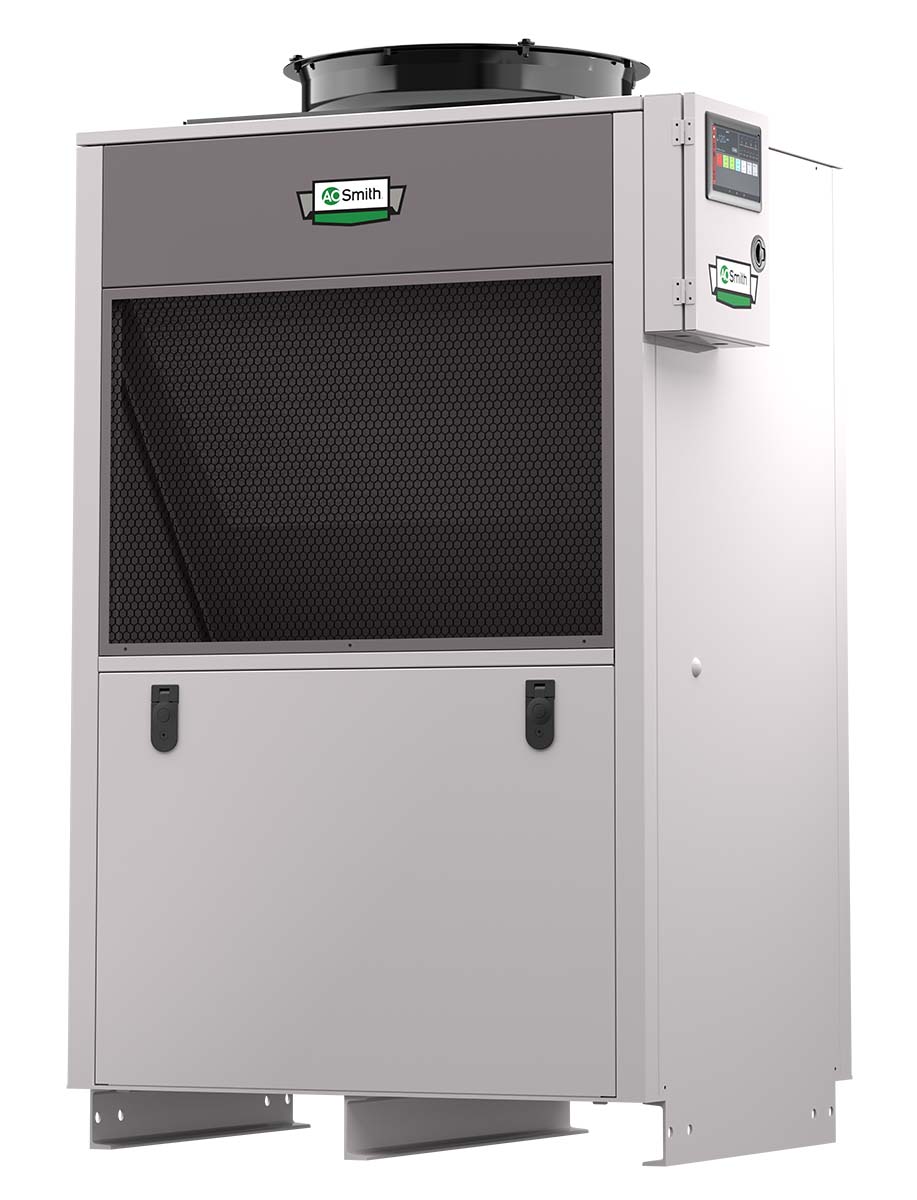
Product name: Emerge X
Type of commercial product: Heat Pump Water Heater
Description: A. O. Smith’s Emerge X Air Source Heat Pump Water Heater optimizes heat transfer and minimizes emissions, making it both environmentally friendly and cost-effective. The unit utilizes a low-GWP refrigerant (R513A) to help meet sustainability goals and adhere to local regulations. The unit’s modular design allows for flexible installation options, and its user-friendly control panel makes it simple to adjust settings and monitor performance. Up to 64 Emerge X HPWHs can be banked together to ensure ample hot water supply, built-in redundancy, and capacity matching for larger commercial water heater demands. The unit’s variable-speed ECM operates in tandem with the flow control valve to provide tighter control of the unit, decrease the noise level, and promote higher efficiency. Thanks to its innovative reversing defrost cycle, the Emerge X HPWH operates at high efficiency in below-freezing temperatures.
How does this product assist with decarbonization efforts in the commercial market?
The unit’s competitive footprint and modular design allow for versatile application in healthcare, fitness clubs, multifamily, and other commercial buildings, aligning with recent regulations promoting high-efficiency heat pumps.
“As more regulations take effect and customer demand increases, heat pump water heaters continue to play a major role in meeting decarbonization goals,” A.O. Smith said in a statement. “We know more customers are actively seeking high-efficiency, eco-friendly products, especially with upcoming DOE regulations going into place for commercial water heating in 2026.”
CARRIER: WATER-SOURCE HEAT PUMP

Product name: AquaZone 50W-Series Water-Source Heat Pumps
Description: The new Carrier AquaZone 50WC water-source heat pump (WSHP) is available from ½ to 6 nominal tons with compact, cost-optimized design in both vertical and horizontal configurations ideal for new construction and replacement applications. The 50WD is available with the same capacity range and offers a higher efficiency level, and two-stage operation from 2 to 6 tons capacity, for enhanced energy savings. The 50WT offers the highest efficiency and two-stage operation from 2 to 60 tons. All 50W-Series models feature more environmentally sustainable Puron Advance refrigerant and include enhanced serviceability features, a wide variety of factory-installed options, and flexible configurations suitable for boiler tower, geothermal, and hybrid water loop systems.
Looking for a reprint of this article?
From high-res PDFs to custom plaques, order your copy today!
How does this product assist with decarbonization efforts in the commercial market?
All models of the AquaZone 50W-Series water-source heat pumps use Puron Advance (R-454B). It’s GWP100 of 466[1] is a 75% reduction from R-410A. WSHPs are fully electric and can also help reduce the overall energy usage for cooling and heating. HVAC systems that use WSHPs can capture energy (through cooling) from one part of a building and transfer it to another part of the building that has a heating demand, meeting a building’s cooling and heating demand without the use of on-site fossil fuels. WSHPs can also use waste heat from a connected process load to provide heating to an occupied space, and can incorporate thermal energy storage strategies to reduce energy demands during peak periods.
DAIKIN APPLIED: PACKAGED ROOFTOP SYSTEM
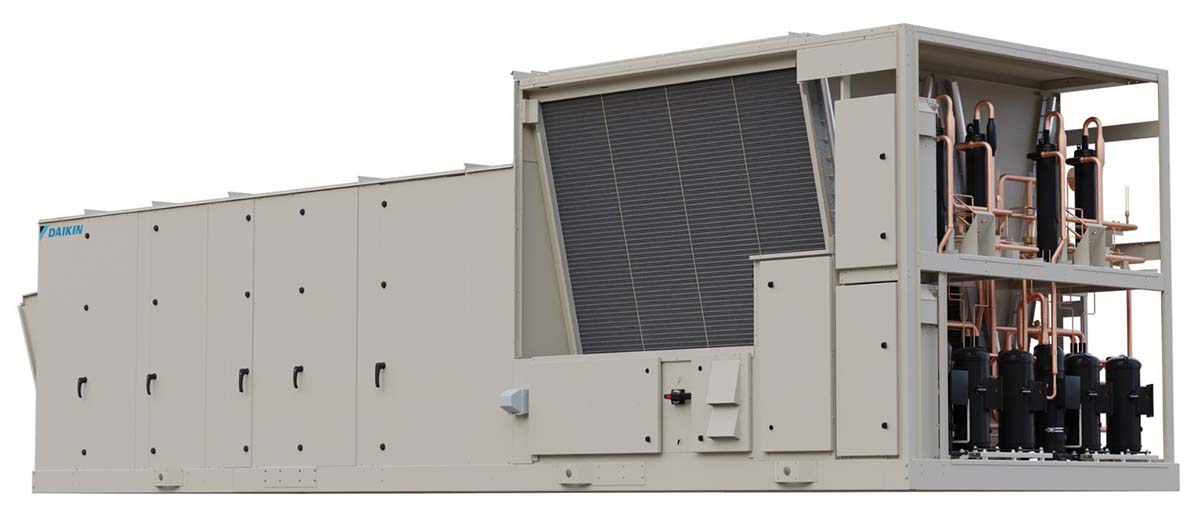
Product name: Rebel Applied Air Source Heat Pump
Description: The Rebel Applied Air Source Heat Pump (ASHP) is a significant enhancement to Daikin Applied’s packaged rooftop system. Using low-GWP R-32 refrigerant and providing 30-68 tons of heating and cooling capacity, this unit offers up to 75% more heating capacity at 0°F compared to current technologies with R-410A refrigerant. The heat pump is an advanced, electrified solution that eliminates or significantly reduces the need for fossil fuels. With the flexibility to pair with various supplemental heat options, including dual fuel, and the existing configurability and enhanced IAQ solutions of Rebel Applied, these units are equipped to serve customers across a wider range of markets and climates. Designed for performance in any conditions, the incorporation of a heating-only boost compressor enhances refrigerant mass flow at low-ambient temperatures, significantly increasing heating capacity while maintaining energy efficiency in both heating and cooling modes. Moreover, the heat pump’s alternating circuit defrost cycle enhances thermal comfort and reduces supplemental heat loads during defrost periods.
How does this product assist with decarbonization efforts in the commercial market?
In the current market, the focus in heat pump development has been on lowering the minimum outdoor ambient conditions at which the unit can operate. However, Rebel Applied shifts this focus towards enhancing unit capacity and efficiency on average design days. While operating at low ambient conditions is important, operating during the coldest 5% of days has less impact on emissions than increasing the coefficient of performance (COP) for the bulk of heating hours. This shift in focus will have massive benefits for building operators and design engineers by increasing the average COP in heating operations, thereby reducing annual utility costs while simultaneously helping the environment through the reduction of fossil fuel use, and aiding the push toward electrification and decarbonization.
“Decarbonizing HVAC centers on three actions: using more environmentally friendly refrigerants, improving energy efficiency, and transitioning to electricity-powered equipment,” Danfoss said in a statement. “The Rebel Applied ASHP checks all the boxes. It uses low-GWP R-32 refrigerant. With 75% more heating capacity at 0°F, it increases average COP and lifetime efficiency. And it’s an electric heat pump that can eliminate or reduce the use of fossil fuels.”
DANFOSS CLIMATE SOLUTIONS: COMPRESSOR
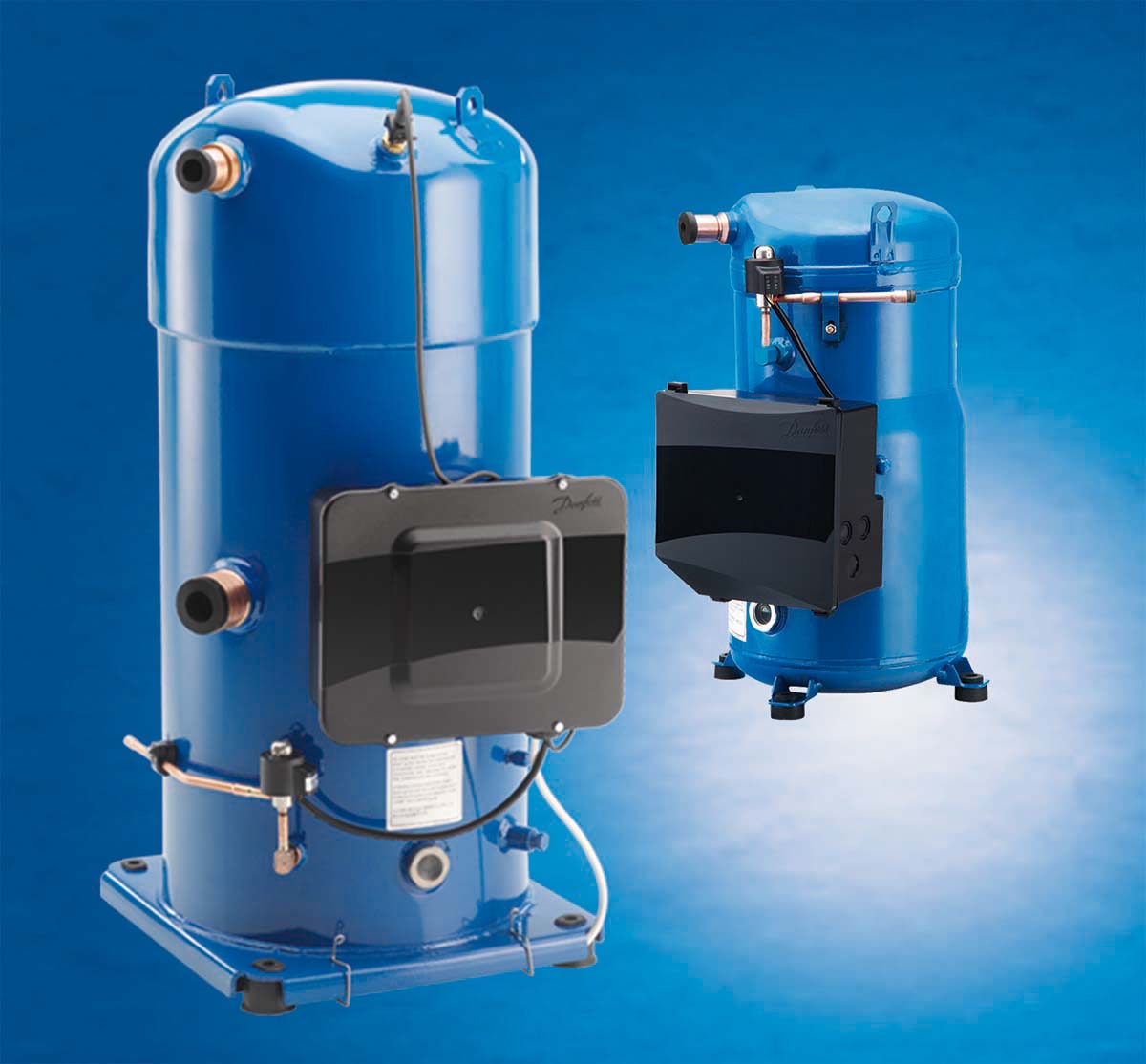
Product name: Compressor/PSH Scroll Range Compressor
Description: The new PSH scroll range compressor features liquid, vapor, and wet injection, along with a full package of qualified components to manage the injection. It delivers year-round comfort with a water-supply temperature of up to 65°C/149°F and is ideal for North American reversible rooftop units and hydronic heat pump systems with higher discharge gas temperature limits. The versatile PSH scroll range is optimized for new-generation systems transitioning to lower GWP options like R454B. The compressor combines the ability to use both liquid and vapor injection in the same product, enabling the PSH to be used in heat pumps in mild climate zones as well as areas where very cold climates are normal and expected. By increasing this operating range, it will further drive the market adoption of heat pumps and decrease the need to burn fossil fuels for heating. It is available in all required voltages and frequencies, which allows it to be used both in the United States and globally. Tandems and trios can also be used with a single economizer heat exchanger, which simplifies the system design and offers greater flexibility. The same compressor can be used for both R410A and R454B and in both liquid and vapor injection operating modes.
How does this product assist with decarbonization efforts in the commercial market?
As an increasing number of states and municipalities enact natural gas bans for new construction and limits on carbon emissions from existing commercial buildings, there will be an increasing demand for cleaner heat sources. Heat pumps are an optimal solution, but in order to reach electrification targets in heating, they will need to be effective in all climates, including those where winter temperatures are regularly below freezing.
With the PSH, “building owners will be able to install systems in new and existing buildings that will be effective in a wider range of temperatures and meet occupant heating needs even on the coldest days,” said Nick Mislak, regional segment marketing director, HVAC, Danfoss Climate Solutions. “Contractors and technicians will appreciate the same high-quality compressor fit and finish, along with the reliability and high-performance efficiency that is standard across the entire Danfoss compressor product range.”
FUJITSU GENERAL AMERICA: COMMERCIAL VRF PUMP AND HEAT RECOVERY SYSTEM
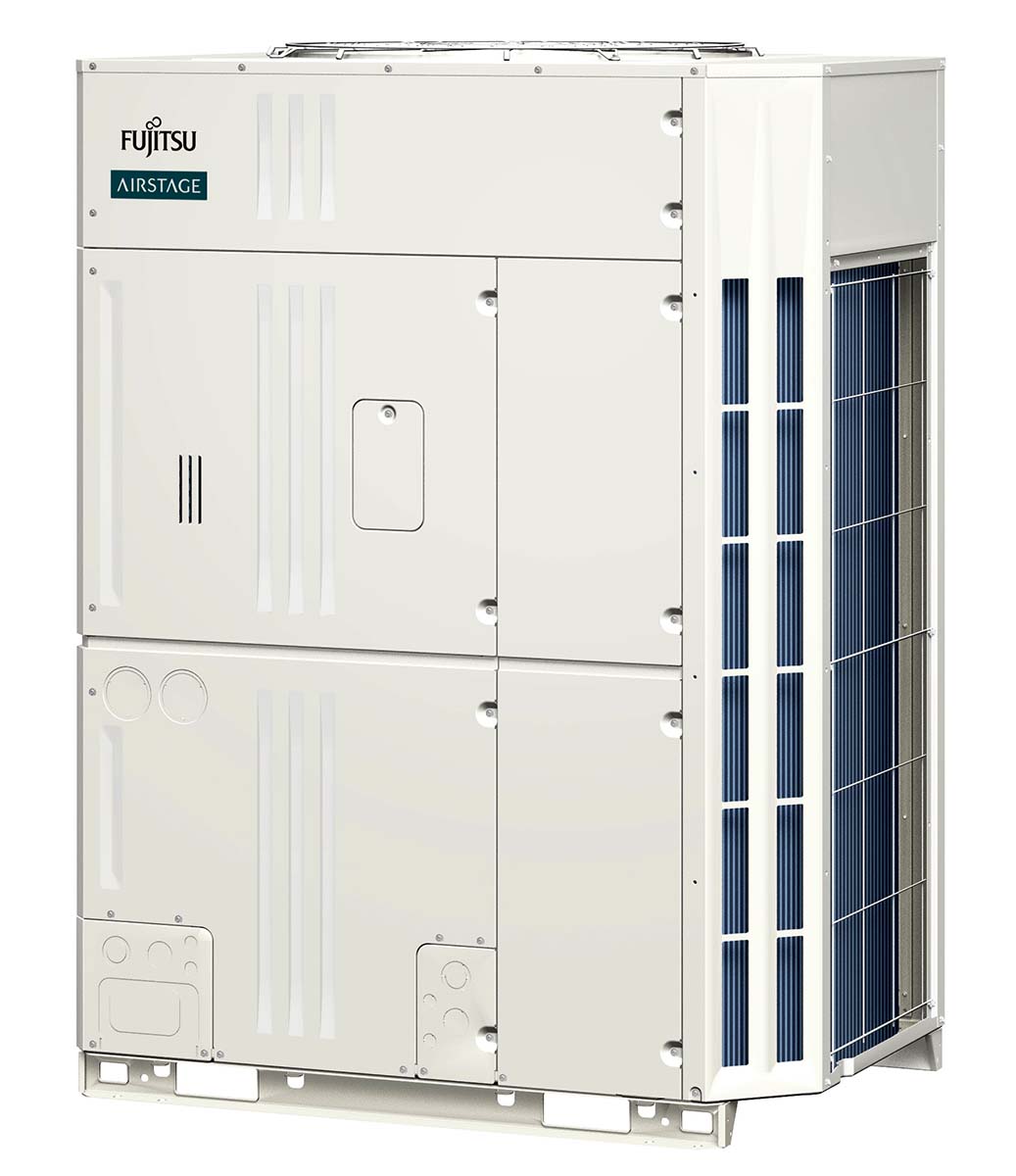
Product name: AIRSTAGE VU-V
Description: Airstage VU-V outdoor units can serve as either heat pumps or heat recovery systems with simple setting changes and the addition of refrigerant branch units (RBUs). The new VRF platform offers broader size ranges, with single modules from 6 to 16 tons, and up to 36 tons per combined system. As many as 64 indoor units can be connected to a single system. Operation in a wider range of outdoor ambient temperatures is provided, with heating capability at outdoor temperatures as low as -15°F. Cooling is provided with outdoor temperatures as high as 126°F, and maximum connected refrigerant pipe is 3,280 feet. This all amounts to greater flexibility, efficiency, and capacity for commercial applications. This latest VRF offering from Fujitsu includes a new service window that provides instant access to the PCB switches and error indicator. Compressor lifecycle is increased due to the Airstage VU-V controls’ ability to rotate the starting unit across all modules in a system. Also, compressor control logic manipulates inverter speed to balance the mass airflow rate of refrigerant in each outdoor unit. Greater indoor comfort is achieved through intelligent refrigerant control corresponding with the heat load of the room.
How does this product assist with decarbonization efforts in the commercial market?
The Fujitsu Airstage VU-V system offers higher efficiency and the ability to operate in extreme outdoor ambient conditions, meaning that heat pump technology can be employed in regions of North America that were previously too hot or too cold for peak operating efficiencies year-round. Greater system sizes, single unit capacities, longer connected line set lengths, and generous indoor unit options allow engineers and installers to employ Airstage VU-V heat pump or heat recovery systems in buildings that may have previously been difficult for VRF installations. The new ability to field-convert VU-V units from heat pump to heat recovery simplifies workflow for everyone in the supply chain, from specification to ordering, stocking, delivery, and installation.
“Moving forward, the success of the decarbonization effort will depend largely on the HVAC industry’s ability to apply high-efficiency heat pump and heat recovery technology to a greater portion of new and existing building infrastructure in North America,” Fujitsu said in a statement. “This requires equipment manufacturers to create products that are greater in capacity, easier to specify and install, and capable of operating efficiently in wider ambient temperature ranges. The Airstage VU-V system was designed specifically with these goals in mind.”
LENNOX COMMERCIAL: PACKAGED ROOFTOP
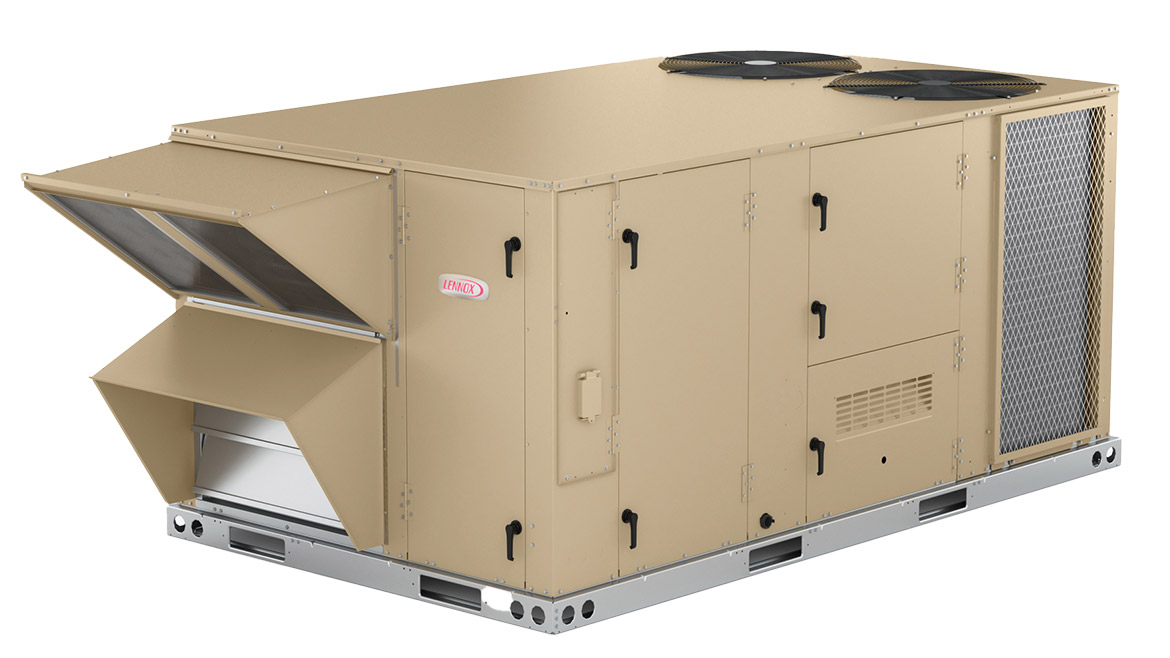
Product name: Enlight High Efficiency Heat Pump
Description: The Lennox Commercial Enlight High Efficiency Heat Pump packaged rooftop units are available from 3 to 25 tons with ratings of up to 16.0 SEER2, 17 IEER, and 12.7 EER2. The Enlight family optimizes comfort and energy usage using a multi-speed cooling system featuring a lead two-speed compressor, variable-speed indoor blower, and fully modulating ECM outdoor fans. The Lennox Core Control System utilizes a mobile service app with built-in wireless gateway, and factory-standard BACnet MS/TP and BACnet IP. This product provides the industry with a full line of high-efficiency heat pumps that are easy to service, easy to integrate, and fully configurable.
How does this product assist with decarbonization efforts in the commercial market?
The Enlight High Efficiency Heat Pump rooftop units utilize advanced technology to improve energy efficiency and reduce greenhouse gas emissions. Enlight’s energy-saving efficiency ratings of up to 16.0 SEER2, 17.0 IEER, and 12.7 EER reduce the HVAC system’s environmental impact while lowering operating costs for the end user. The 6.5- to 25-ton units provide independent defrost cycles, which reduce the runtime of auxiliary heat and lower energy usage by staging the defrost cycle of each compressor without multiple refrigerant circuits being in defrost simultaneously. The Lennox Core Unit Controller enables open integration and control with standard BACnet IP & MS/TP. Options for LONTalk, and the choice of thermostat or room sensors allow freedom of choice and custom monitoring and control. The Enlight, along with advanced control from the Core Control System, allows for compression heating in the mid-to-low ambient ranges without the need for large-capacity auxiliary heaters and sometimes without the need for auxiliary heat at all.
“This enables the options for energy delivery from renewable resources such as solar and wind to supply power for both compression and auxiliary electrical heat,” Lennox said in a statement. “The ability to efficiently operate compression heat in a broad range of outdoor ambient temperatures also reduces the need for gas furnace auxiliary heating where electrical services or the installation region does not allow.”
LG ELECTRONICS: Inverter Heat Pump Scroll Chiller
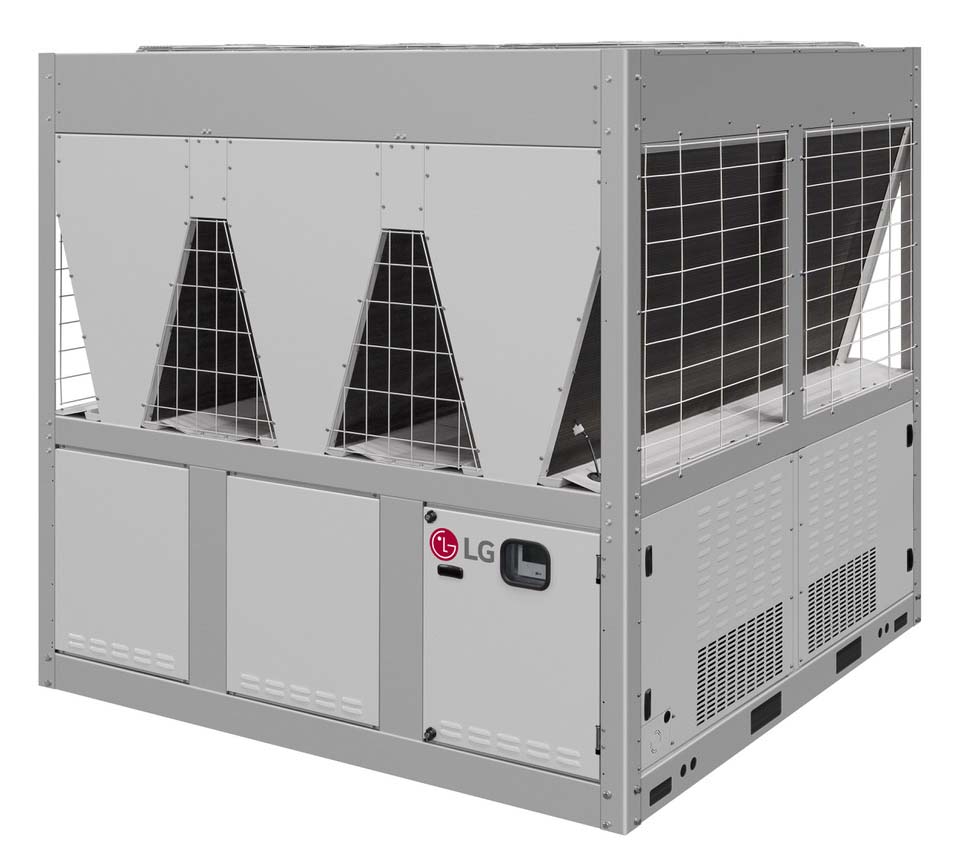
Product name: R32 Inverter Scroll Heat Pump Chiller
Description: Utilizing a lower-GWP refrigerant and all-inverter system that allows for variable-speed operation, the R32 Inverter Scroll Heat Pump Chiller is a compact, easy-to-install solution that prioritizes efficient performance and energy-saving opportunities with its wide operating range and part load efficiency, delivering reliable heating and cooling for commercial applications.
How does this product assist with decarbonization efforts in the commercial market?
LG variable-speed HVAC chillers use control logic to precisely match building load requirements by controlling the compressor and condenser fan speed, optimizing energy resources. Specifically, LG’s heat pump air-cooled chillers are reverse cycle heat pumps capable of producing hot water for comfort heating and domestic hot water with a coefficient of performance (COP) of 3.5, meaning the output per unit of energy input in heating is 3.5 times greater.
“LG’s heat pump chiller technology is powered by electricity, which reduces the consumption of fossil fuels when compared to fossil-fuel-based heating devices, all while maintaining comfort and domestic hot water production,” said Patrick Richardson, application engineer at LG Air Conditioning Technologies. “The demand for decarbonization will persist through codes and regulations. Investing in electrification makes financial and environmental sense and aligns with regulatory standards.”
MITSUBISHI ELECTRIC TRANE HVAC US (METUS): HYBRID VARIABLE REFRIGERANT FLOW SYSTEMS
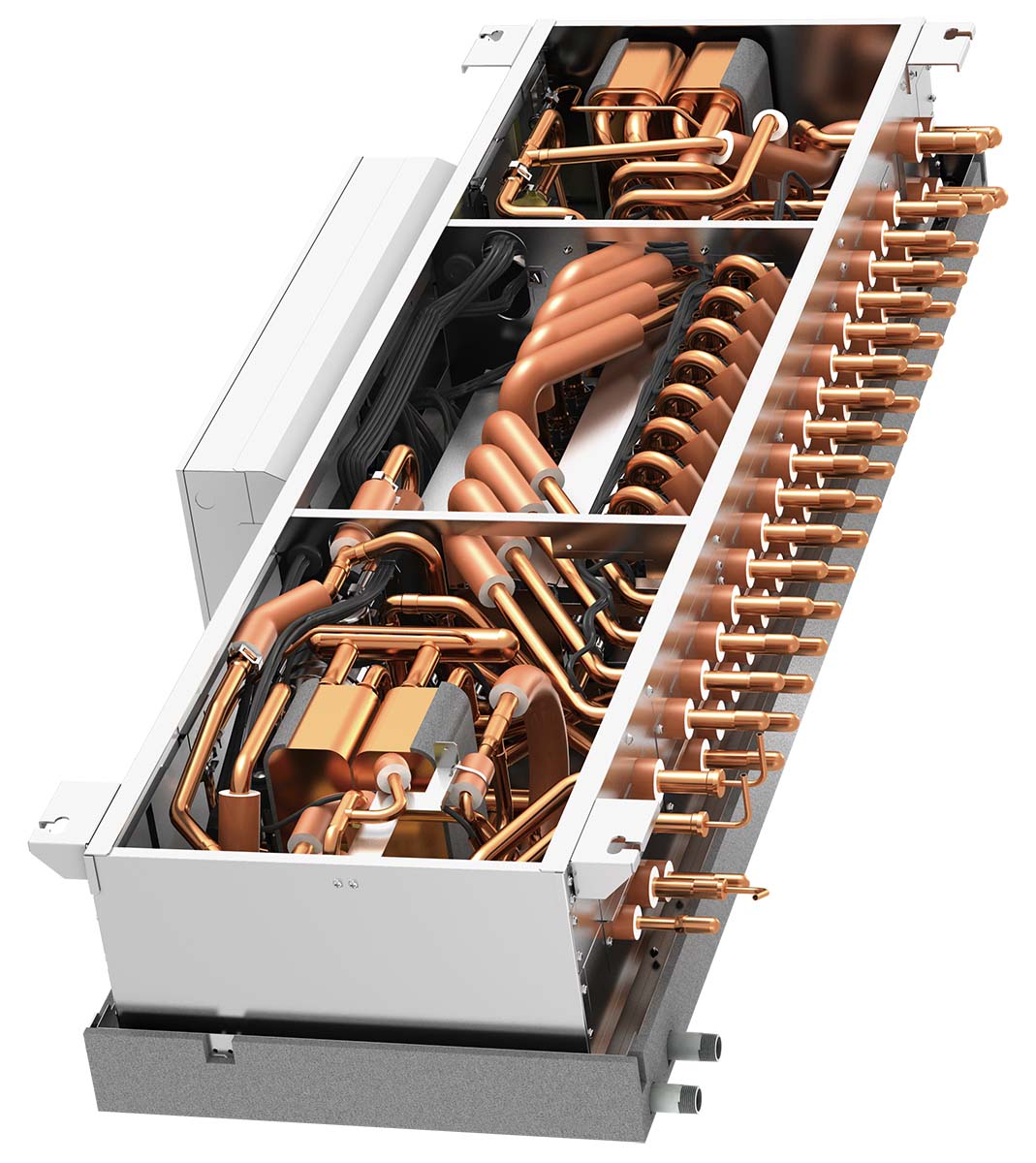
Product name: Mitsubishi Electric Hybrid VRF
Description: The Mitsubishi Electric Hybrid VRF is a two-pipe variable refrigerant flow (VRF) zoning system designed to use water instead of refrigerant in indoor spaces. The Hybrid VRF system exchanges heat between refrigerant and water using the Hybrid Branch Circuit (HBC) Controller, allowing for simultaneous heating and cooling while keeping indoor piping refrigerant-free. Featuring compatibility with standard and high-efficiency City Multi N-Generation outdoor units and L-Generation water-source units, and the ability to scale with the use of Sub-HBC Controllers, Hybrid VRF gives the industry a flexible all-electric heat pump solution. Hybrid VRF can be tailored to fit various applications with specific zoning requirements, such as hotels, office buildings, multifamily buildings, schools, dorms, and senior living facilities.
How does this product assist with decarbonization efforts in the commercial market?
Hybrid VRF was designed with future refrigerant restrictions in mind. Also, unlike conventional commercial HVAC systems, Hybrid VRF does not rely on gas, oil, or propane for heating. Its indoor units can be controlled by individual remotes through zoned heating and air conditioning, as well as through a centralized controller or BMS, enabling users to more efficiently control energy usage and help reduce the carbon footprint.
“Hybrid VRF offers the commercial market an innovative, efficient alternative to conventional HVAC systems,” METUS said in a statement. “As building owners, engineers, and architects consider new refrigerant regulations and design challenges attributed to ASHRAE 15, as well as national and local decarbonization rules, Hybrid VRF is an all-electric zoned comfort solution. Because the technology uses water for heat transfer at indoor units and provides simultaneous heating and cooling, Hybrid VRF is scalable and suitable for many building applications, even in low ambient conditions.”
RHEEM MANUFACTURING: PACKAGED HEAT PUMP
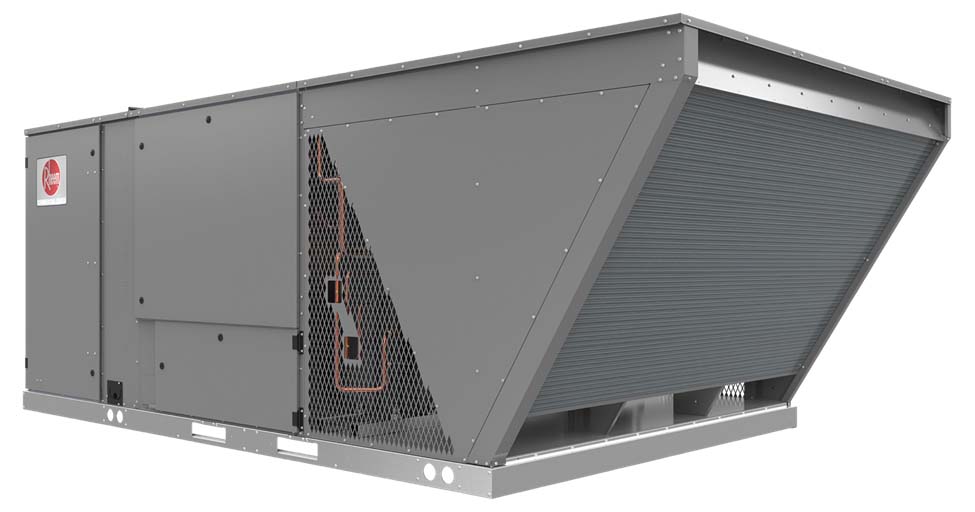
Product name: Rheem Resolute Line Classic Series Packaged Heat Pump
Description: The Rheem Resolute heat pump (model RHPHYB) is offered in 15 and 20 tons and boasts a number of features. The units are a great choice for new construction and retrofit projects in a broad range of commercial applications with two stages of heating and cooling, heat pump operation, and several premium features that come standard that enhance overall ROI. Offered as part of the new Rheem lineup of low-GWP refrigerant products, notable unit features include PlusOne ServiceSmart package with Qwik-Slide blower assembly, Qwik-Clean slide-out drain pan, and standard hinged panel access. The unit also offers single-point electrical connections, standard phase protection monitor, and a built-in refrigerant detection system to comply with AIM Act requirements. Users may also opt for the optional PlusOne ClearControl for easy connectivity via BACnet, LonWorks, or Modbus. Contractors and facilities managers can reduce time spent performing industry-standard service and preventative maintenance with thoughtfully engineered standard features like hinged panel access, single-point wiring, and easily removable assemblies.
How does this product assist with decarbonization efforts in the commercial market?
A proven sustainable option for meeting decarbonization and electrification goals, the Rheem Resolute Heat Pump delivers up to 13.5 IEER, 10.6 EER, and 3.3 COP, and meets the low-GWP refrigerant requirements of the AIM Act of 2020 that go into effect Jan. 1, 2025.
With decarbonization at the forefront of many new builds and remodels in the commercial market, Rheem Resolute units are designed with the right mix of premium features to maximize energy savings, reliability, comfort, and value. Resolute products are a great choice for new construction and replacement projects. Standard single-point wiring and hinged panel access make the product easier to service and install, while technologies like Rheem’s removable blower assembly with VFD deliver on efficiency.
“Rheem Resolute boasts higher efficiencies playing into the decarbonization trend,” said Chet Biggs, commercial product manager at Rheem. “Additionally, the unit has VFD technology, which boosts energy savings by matching system capacity to the actual load while reducing wear and tear on motor components.”
TRANE: BUILDING AUTOMATION SYSTEMS (BAS)
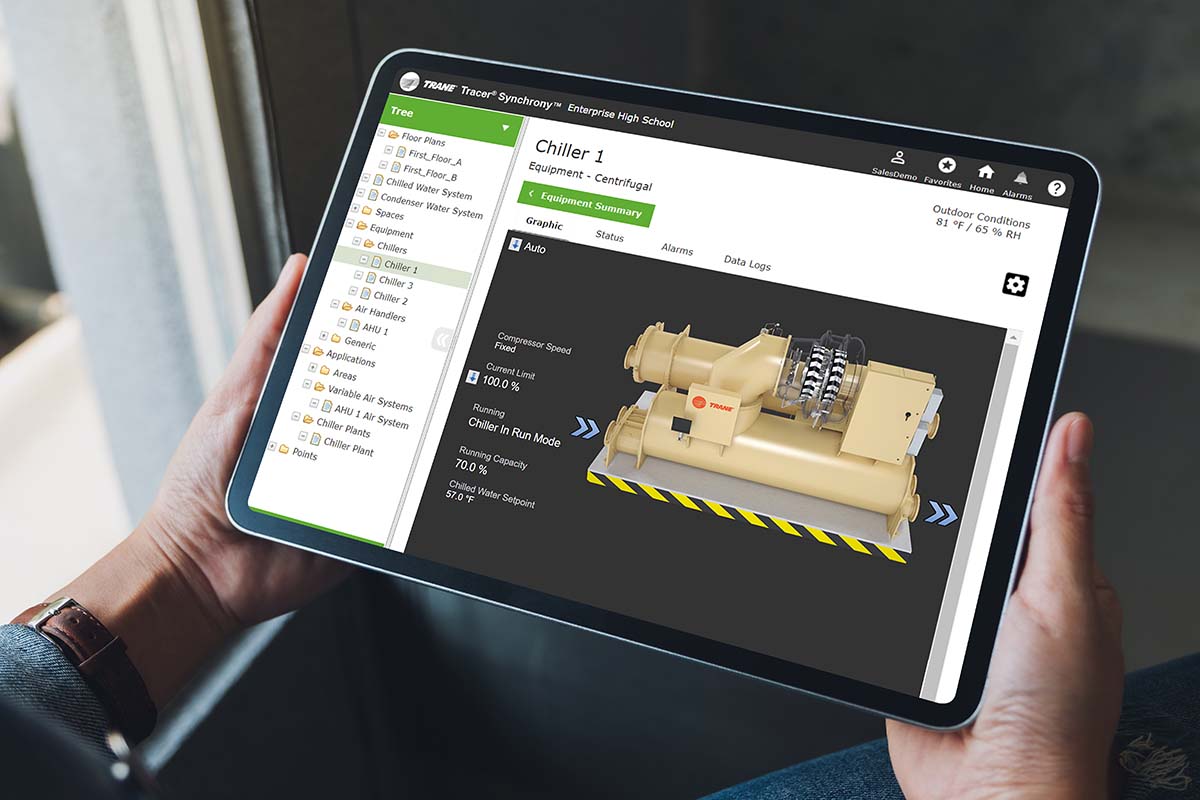
Product name: Trane Tracer SC+
Description: Trane Tracer SC+ is a BAS that integrates data from HVAC equipment to simplify command and provide better control over comfort and efficiency. Built on a foundation of industry-standard open protocols, including BACnet, LonTalk, and Modbus, Tracer SC+ provides robust support for Trane and non-Trane equipment from all generations so building owners and managers can align sustainability with profitability. With Trane’s embedded logic, Tracer SC+ delivers optimal energy performance straight out of the box. Pre-engineered applications include chiller plant control, area, variable air systems (VAS), trim and respond, linear reset, demand management, scheduling, and more. Users can also automate the coordination of advanced sustainability solutions including free cooling, thermal storage, and daylight harvesting. With a simple communications bridge, Tracer SC+ can provide facility and building managers the flexibility to replace aging equipment over time, as budget allows, to create smart, connected buildings that are responsive to occupants and set new standards for sustainability. The latest software release included enhanced capabilities to control chiller plants to optimize rotation, staging, and sequencing of multiple chillers to accommodate dynamic building loads while maximizing chiller life.
How does this product assist with decarbonization efforts in the commercial market?
Peak decarbonization benefits can be gained through expert system sequencing and scheduling of HVAC equipment, and Tracer SC+ helps commercial building owners and managers create those repeatable control strategies. Even existing systems with older equipment can show significant improvement when modern controls are introduced. Maximum HVAC system decarbonization requires commercial buildings to monitor energy continuously, through a system like Tracer SC+, using data insights and automation to manage improvements.
A building automation system (BAS) is a tool that provides a centralized hub to visualize, monitor, and optimize all building systems, including fire, lighting, security, and HVAC — which helps to increase energy efficiency.
“Connected building automation systems, like Tracer SC+, support operators by providing actionable data and analytics, helping them identify problems and opportunities to improve the building’s performance,” Trane said in a statement. “When a building is equipped with a BAS, there is the double benefit of having all the building’s data that can be used to act on and reduce energy use and intensity.”

